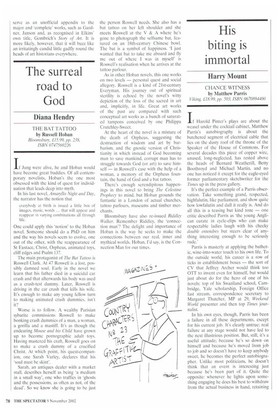The surreal road to God
Diana Hendry
THE HAT TATTOO by Russell Hoban Bloomsbury, £15.99, pp. 238, ISBN 0747560226 If Jung were alive, he and Hoban would have become great buddies. Of all contemporary novelists, Hoban's the one most obsessed with the kind of quest for individuation that leads deep into myth.
In his last novel, Amaryllis Night and Day, the narrator has the notion that
everybody at birth is issued a little box of images, music, words ... that will appear and reappear in varying combinations all through life.
One could apply this 'notion' to the Hoban novel. Someone should do a PhD on him and the way his novels seem to evolve, one out of the other, with the reappearance of St Eustace, Christ, Orpheus, animated toys, cliff edges and Psalm 137.
The main protagonist of The Bat Tattoo is Roswell Clark. At 47 Roswell is a lost. possibly damned soul. Early in the novel we learn that his father died in a suicidal car crash and that afterwards his body was used as a crash-test dummy. Later, Roswell is driving in the car crash that kills his wife. It's enough to make any young fellow turn to making animated crash dummies, isn't it?
Worse is to follow. A wealthy Parisian sybarite commissions Roswell to make bonking crash dummies of a man, a woman, a gorilla and a mastiff. It's as though the endearing Mouse and his Child have grown up to become pornographic adult toys. Having mastered his craft, Roswell goes on to make a crash dummy of a crucified Christ. At which point, his quest-companion, one Sarah Varley, declares that his 'soul must be skint'.
Sarah, an antiques dealer with a market stall, describes herself as being 'a medium in a small way', one who traffics in 'ghosts and the possessions, as often as not, of the dead'. So we know she is going to be just the person Roswell needs. She also has a bat tattoo on her left shoulder and she meets Roswell at the V & A where he's gone to photograph the selfsame bat, featured on an 18th-century Chinese bowl. The bat is a symbol of happiness. 'I just wanted that bat to take me aboard and fly me out of where I was in myself is Roswell's realisation when he arrives at the tattoo parlour.
As in other Hoban novels, this one works on two levels — personal quest and social allegory. Roswell is a kind of 21st-century Everyman. His journey out of spiritual sterility is echoed by the novel's witty depiction of the loss of the sacred in art and, implicitly, in life. Great art works of the past are compared with such conceptual art works as a bunch of saturated tampons conceived by one Philippa Crutchley-Sweet.
At the heart of the novel is a mixture of the death of Orpheus, suggesting the destruction of wisdom and art by barbarism, and the gnostic version of Christianity; in which instead of God becoming man to save mankind, corrupt man has to struggle towards God (or art) to save himself — in Roswell's case with the help of a woman, a memory of the Orpheus fountain, the hand of God and a bat tattoo.
There's enough serendipitous happenings in this novel to bring The Celestine Prophecy to mind, but Hoban grounds the fantastic in a London of actual churches, tattoo parlours, museums and timber merchants.
Bloomsbury have also re-issued Riddley Walker. Remember Riddley, the 'connection man'? The delight and importance of Hoban is the way he seeks to make the connections between our real, inner and mythical worlds. Hoban, I'd say, is the Connection Man for our times.


















































































































 Previous page
Previous page